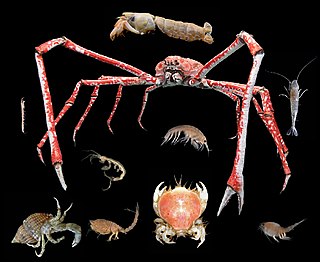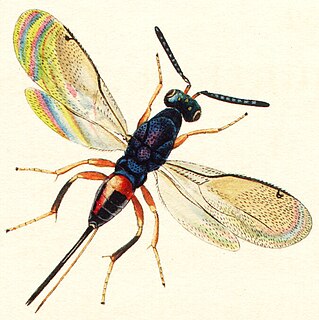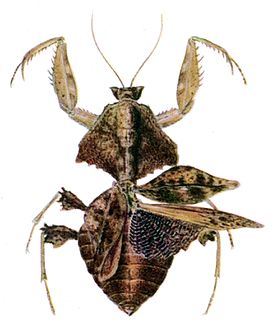
The ringtail is a mammal of the raccoon family native to arid regions of North America. It is widely distributed and well adapted to disturbed areas. It has been legally trapped for its fur. It is listed as Least Concern on the IUCN Red List. It is also known as the ringtail cat, ring-tailed cat, miner's cat or bassarisk, and is sometimes called a cacomistle, though this term seems to be more often used to refer to Bassariscus sumichrasti.

Mantis shrimp, or stomatopods, are carnivorous marine crustaceans of the order Stomatopoda, branching from other members of the class Malacostraca around 340 million years ago. Mantis shrimps typically grow to around 10 cm (3.9 in) in length, while a few can reach up to 38 cm (15 in). The largest mantis shrimp ever caught had a length of 46 cm (18 in); it was caught in the Indian River near Fort Pierce, Florida, in the United States. A mantis shrimp's carapace covers only the rear part of the head and the first four segments of the thorax. Varieties range in color from shades of brown to vivid colors, with more than 450 species of mantis shrimps being known. They are among the most important predators in many shallow, tropical and subtropical marine habitats. However, despite being common, they are poorly understood, as many species spend most of their lives tucked away in burrows and holes.

Malacostraca is the largest of the six classes of crustaceans, containing about 40,000 living species, divided among 16 orders. Its members, the malacostracans, display a great diversity of body forms and include crabs, lobsters, crayfish, shrimp, krill, woodlice, amphipods, mantis shrimp and many other, less familiar animals. They are abundant in all marine environments and have colonised freshwater and terrestrial habitats. They are segmented animals, united by a common body plan comprising 20 body segments, and divided into a head, thorax, and abdomen.

The pacarana is a rare and slow-moving hystricognath rodent indigenous to South America. Native Tupi people call it the pacarana because it is superficially similar to the paca, a different rodent which is not in the same family. The pacarana has a chunky body and is large for a rodent, weighing up to 15 kg (33 lb) and measuring up to 79 cm (31 in) in length, not including the thick, furry tail.

The cacomistle is a nocturnal, arboreal and omnivorous member of the carnivoran family Procyonidae. Its preferred habitats are wet, tropical, evergreen woodlands and mountain forests, though seasonally it will venture into drier deciduous forests.

Torymidae is a family of wasps in the superfamily Chalcidoidea. Most species in this family are small with attractive metallic coloration, and females generally have long ovipositors. Many are parasitoids on gall-forming insects, and some are phytophagous (plant-eating) species, sometimes using the galls formed by other insects. Over 960 species in about 70 genera are found worldwide. They are best recognized in that they are one of the few groups of Chalcidoidea in which the cerci are visible.
Animal Diversity Web (ADW) is an online database that collects the natural history, classification, species characteristics, conservation biology, and distribution information on thousands of species of animals. The website includes thousands of photographs, hundreds of sound clips, and a virtual museum.

Flower mantises are those species of praying mantises that mimic flowers. Their coloration is an example of aggressive mimicry, a form of camouflage in which a predator's colours and patterns lure prey. The flower mantises are not a natural group with a single ancestor, but most of the species are in the family Hymenopodidae. Their behaviours vary, but typically involve climbing a plant, and then staying still until a prey insect comes within range. Many species of flower mantises are popular as pets.

Ambush predators or sit-and-wait predators are carnivorous animals that capture or trap prey by stealth or by strategy, rather than by speed or by strength. Ambush predators sit and wait for prey, often from a concealed position, and then launch a rapid surprise attack.

Sumichrast's vesper rat is a rodent of the family Cricetidae found from southern Mexico to Panama. It is named for the collector of the first specimen, and its closest relative is probably Hatt's vesper rat, a similar, but slightly smaller, species from the Yucatán Peninsula.
Sumichrast's harvest mouse is a species of rodent in the family Cricetidae. It is found in Costa Rica, El Salvador, Guatemala, Honduras, Mexico, Nicaragua, and Panama.

The citreoline trogon is a species of bird in the family Trogonidae. It is endemic to western Mexico, with an estimated distribution size of 539,000 km2 Due to this very large range, the IUCN consider it a species of Least Concern and that the current population trend is stable. T. citreolus has also been studied as an Ecosystem engineer.

Orthodera novaezealandiae, known as the New Zealand mantis or the New Zealand praying mantis, is a species of praying mantis which is, as both the scientific name and common names suggest, indigenous and endemic to New Zealand.

Mantises are an order (Mantodea) of insects that contains over 2,400 species in about 430 genera in 30 families. The largest family is the Mantidae ("mantids"). Mantises are distributed worldwide in temperate and tropical habitats. They have triangular heads with bulging eyes supported on flexible necks. Their elongated bodies may or may not have wings, but all Mantodea have forelegs that are greatly enlarged and adapted for catching and gripping prey; their upright posture, while remaining stationary with forearms folded, has led to the common name praying mantis.

Brancsikia freyi is the type species in its genus of praying mantids: in the family Majangidae.

Woodhouse's scrub jay, is a species of scrub jay native to western North America, ranging from southeastern Oregon and southern Idaho to central Mexico. Woodhouse's scrub jay was until recently considered the same species as the California scrub jay, and collectively called the western scrub jay. Prior to that both of them were also considered the same species as the island scrub jay and the Florida scrub jay; the taxon was then called simply the scrub jay. Woodhouse's scrub jay is nonmigratory and can be found in urban areas, where it can become tame and will come to bird feeders. While many refer to scrub jays as "blue jays", the blue jay is a different species of bird entirely. Woodhouse's scrub jay is named for the American naturalist and explorer Samuel Washington Woodhouse.
Phasmomantis is a genus of mantis of the family Mantidae.

Squilla empusa is a species of mantis shrimp found in coastal areas of the western Atlantic Ocean. It excavates and occupies a burrow in soft sediment from which it emerges, mainly at night, to feed on fish and invertebrate prey.
Brancsikia areoplana is a species of praying mantis from Madagascar, in the family Majangidae.














